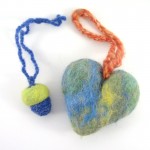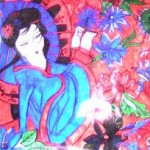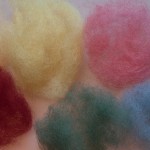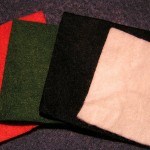 Mitten ornaments made out of felt are really easy to make. Especially during Christmas time you can hang them on your Christmas tree. First of all make the shape of a mitten on a piece of paper. Then cut it out. Make use of this pattern to cut the top layer of mitten from the felt of wool. Select the design that you want to make out of that mitten, then cut out shapes that are solid from the different colours of wool felt. Put the mitten on the top of the felting brush and arrange the pieces of felt. Use the tools of felting and take the instructions of the manufacturer. Continue adding and layering the pieces of felt on one another till the design is complete. Cut the piece of cuff and try and reach the desired thinckness. Tack the cuff to the top of the mitten with the help of felting needle tool. Place the felting brush on the top of the mitten and save the two layers together.To finish the sewing of mitten use felted balls to the right corner of the cuff using making some embroidery and a large cross-stitch. Add a hanging loop to make it look fancy.
Mitten ornaments made out of felt are really easy to make. Especially during Christmas time you can hang them on your Christmas tree. First of all make the shape of a mitten on a piece of paper. Then cut it out. Make use of this pattern to cut the top layer of mitten from the felt of wool. Select the design that you want to make out of that mitten, then cut out shapes that are solid from the different colours of wool felt. Put the mitten on the top of the felting brush and arrange the pieces of felt. Use the tools of felting and take the instructions of the manufacturer. Continue adding and layering the pieces of felt on one another till the design is complete. Cut the piece of cuff and try and reach the desired thinckness. Tack the cuff to the top of the mitten with the help of felting needle tool. Place the felting brush on the top of the mitten and save the two layers together.To finish the sewing of mitten use felted balls to the right corner of the cuff using making some embroidery and a large cross-stitch. Add a hanging loop to make it look fancy.
felt
More about Felt Making
 In order to bring the product in the right shape, we keep it in the sun light to dry it up, hence, drying of the felt is done in a complete natural way. No machines are used to heat up for the drying purpose. After the process in which the product is made wet, sunlight is used to dry it up quickly. After drying up depending upon what design needs to be given to the final product little bit of sewing and gluing is done to the product to give it the correct design. Most of the felt products that are made are made by poor or the disadvantaged people, who have little money and these item are traded in the fairs and are hence, called trade items. Therefore, buying these felt products or items can turn out to be a great support to these poor people and can help them in a lot of ways. Different kinds of products that are made by felt are bedsheets, bags, shoes, felt accessories, purses, necklaces, scarves, hat and other craft items. They look beautiful once they are made.
In order to bring the product in the right shape, we keep it in the sun light to dry it up, hence, drying of the felt is done in a complete natural way. No machines are used to heat up for the drying purpose. After the process in which the product is made wet, sunlight is used to dry it up quickly. After drying up depending upon what design needs to be given to the final product little bit of sewing and gluing is done to the product to give it the correct design. Most of the felt products that are made are made by poor or the disadvantaged people, who have little money and these item are traded in the fairs and are hence, called trade items. Therefore, buying these felt products or items can turn out to be a great support to these poor people and can help them in a lot of ways. Different kinds of products that are made by felt are bedsheets, bags, shoes, felt accessories, purses, necklaces, scarves, hat and other craft items. They look beautiful once they are made.
Different products made out of Felt
 Felt is a kind of a fabric that is made up of condensed matted fibers of animals. The wool of the lamb is imported to New Zealand. This is considered the best wool in the whole world. To begin with first of all carding is done to the wool. After which it is dyed into various different colours. For this the dying can be done both by hand and the machine. But dying from the machine is a more practical way of getting the colour on the wool faster. After the colouring is done, the labour which is mostly the women workers start compressing the wool (which in other terms known as the raw material). This is done with the help of hot water and washing soap. They do it with hands. No chemical or machine is used to make the final product. Therefore, you can say that the felt products are completely made by hand or hand made. The product is well blocked and well – shaped, hence, well produced and not any kind of sewing, patching, washing, rubbing is done to the product.
Felt is a kind of a fabric that is made up of condensed matted fibers of animals. The wool of the lamb is imported to New Zealand. This is considered the best wool in the whole world. To begin with first of all carding is done to the wool. After which it is dyed into various different colours. For this the dying can be done both by hand and the machine. But dying from the machine is a more practical way of getting the colour on the wool faster. After the colouring is done, the labour which is mostly the women workers start compressing the wool (which in other terms known as the raw material). This is done with the help of hot water and washing soap. They do it with hands. No chemical or machine is used to make the final product. Therefore, you can say that the felt products are completely made by hand or hand made. The product is well blocked and well – shaped, hence, well produced and not any kind of sewing, patching, washing, rubbing is done to the product.
The historic process of felt making
Felt is an organic fabric that is produced from wool. The process itself takes a long history, first mention of felt production date to 6500 B.C.  From the ancient history we can proudly claim, that the felt is the oldest fabric known to man. This warm and easily made product was used on wall paintings as the motif of felt applique from 6500 to 3000 B.C in Turkey. Another traces are in the frozen tombs on the north of Siberia and date around 700 B.C. The tribes were producing mainly clothing, saddles, tents. Due to its characteristics, felt tents were strong, water and snow proof, meanwhile inside of the tent it was cozy and friendly.
From the ancient history we can proudly claim, that the felt is the oldest fabric known to man. This warm and easily made product was used on wall paintings as the motif of felt applique from 6500 to 3000 B.C in Turkey. Another traces are in the frozen tombs on the north of Siberia and date around 700 B.C. The tribes were producing mainly clothing, saddles, tents. Due to its characteristics, felt tents were strong, water and snow proof, meanwhile inside of the tent it was cozy and friendly.
The saint patron of felt
As the centuries passed away, felt remained. The Romans discovered process of making felt by a chance, when St. Clement, a wandering monk, stuffed his sandals with a wool to make them more comfortable. The fibers combined with the moisture from sweat and the pressure from his feet produced a fabric, felt. Afterwards, as he was established a bishop, he developed felting process and became the patron of hatmakers, who are working with felt to this day.
Modern ways of production
If we travel to the far East, in Central Asia there are still tribes, that practice feltmaking to produce their tents, traditionally called yurts, clothing, rugs. Currently, the usage of felt is represented in industry as well as in consumer sector. There are 2 main types of processed how is felt produced. Either we are speaking about wet felting or needle felt.
Wet felting
With wet felting, we can use the wool or other animal fibers. The process itself involves the application of warm, soapy water on fibers applied to layers at 90 degree angles to each other until they are hooked together. At the end, the felt material may be finished by fulling. The result is that the felt is thicker and waterproofed.
Needle felt
Compared to the first process, in this one we do not use water. In this case, special needles are used in industrial felting machine. The needles are constructed the way that after each insertion to felt, they hook up together and the result is a fabric, that can be strengthened by chemicals or by steam. This production is much more cheaper that pre previous one, so the most of the felt is produced this way. In this process we can switch the organic wool to synthetic fibers. Clearly, the felt is an irreplaceable product that was proved by centuries and its production was improved to the version that we use these days.